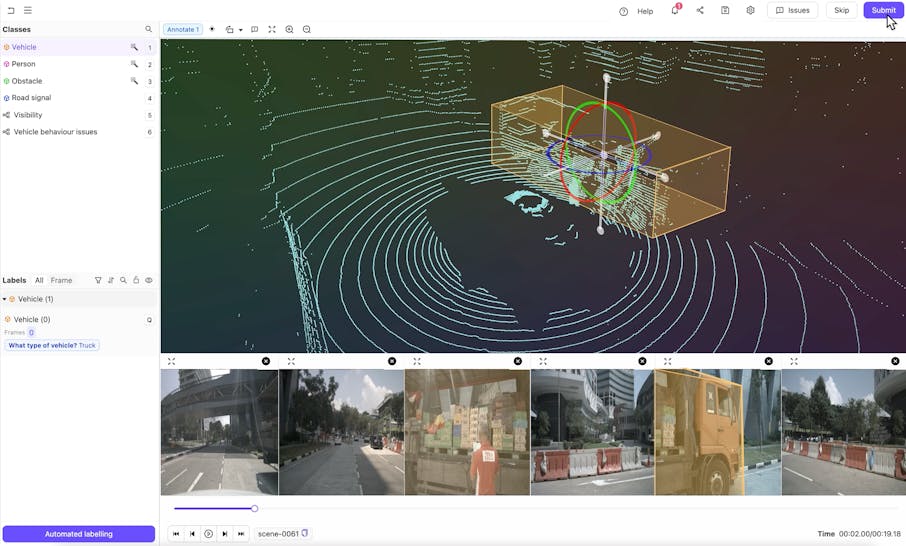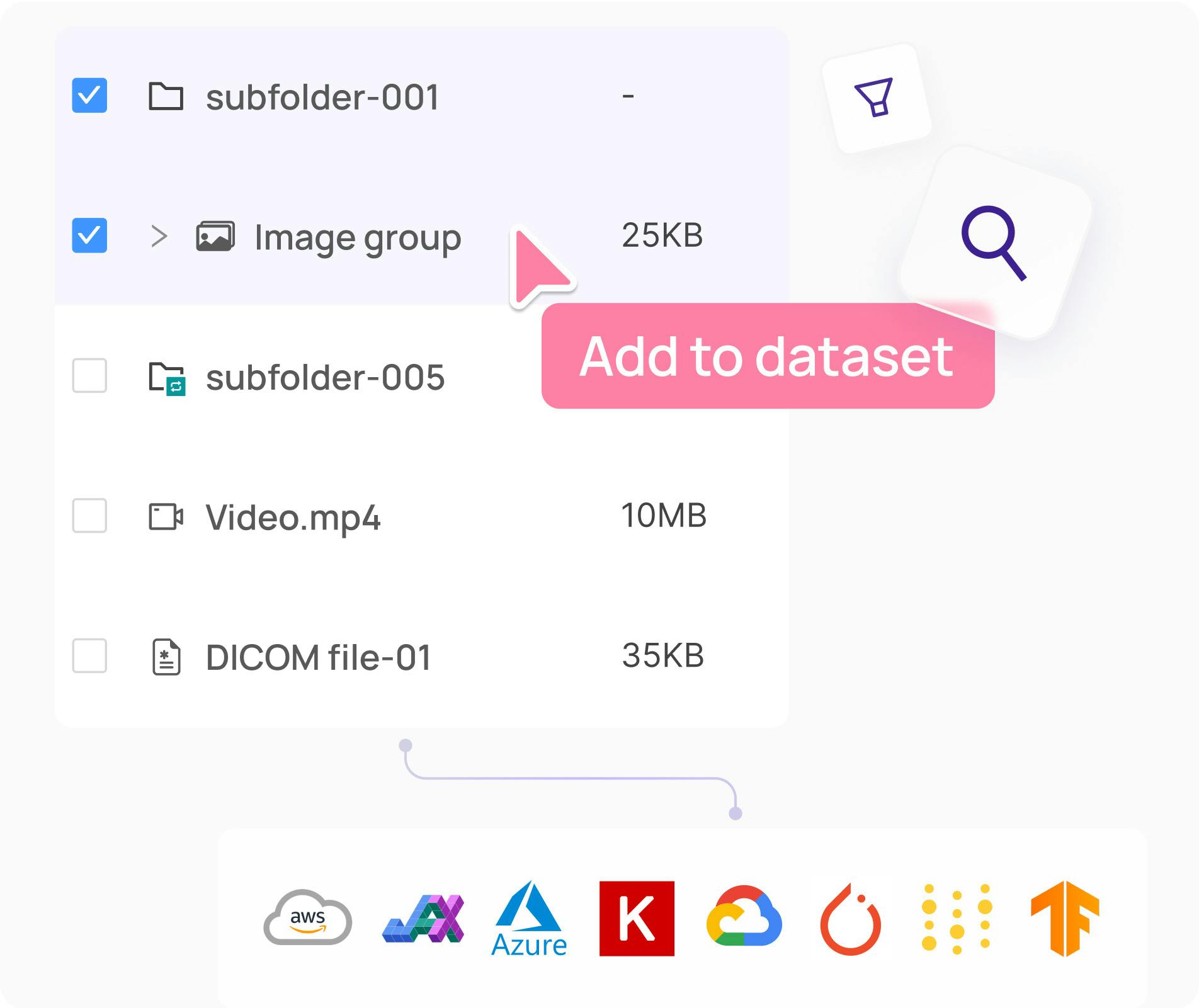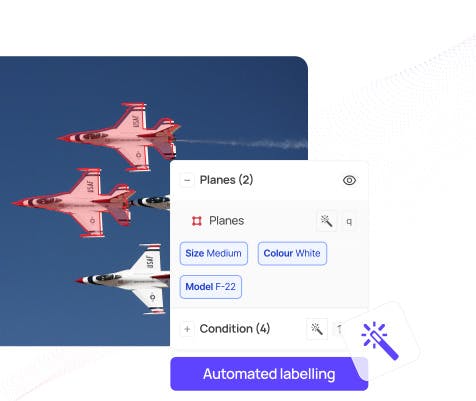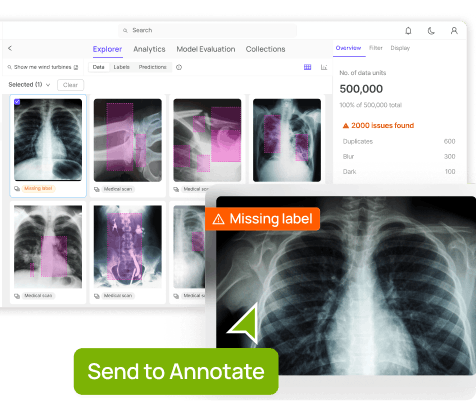Contents
Why Encord for LiDAR Annotation
Reviews
What to evaluate (and why it matters)
Encord Blog
Best LiDAR Annotation Platforms (2025): Fast, Accurate, Sensor-Fusion Ready
5 min read

When it comes to LiDAR annotation, there is no single best platform for every team—but there are clear leaders depending on your use case. In LiDAR annotation, success goes beyond drawing 3D cuboids. Teams working on autonomous driving, robotics, mapping, and safety-critical AI need end-to-end workflows, rigorous quality assurance, and enterprise-grade governance. That’s where Encord stands out.
Other platforms also have strengths: Segments.ai and Supervisely are known for fast, purpose-built 3D point cloud editors; Labelbox lacks lidar; Deepen AI and Basic.ai combine software with a managed labeling workforce; AWS SageMaker Ground Truth is a natural fit for organizations locked into AWS; and CVAT and Label Studio remain strong open-source starting points for teams who want to self-host.
But if you need to scale LiDAR annotation with accuracy, governance, and multimodal use cases, Encord delivers.
Why Encord for LiDAR Annotation
Encord is more than an annotation tool—it is a unified AI data layer designed for AI teams building perception systems.
- Full workflow coverage: annotation, curation, evaluation, and governance in a single platform.
- Advanced 3D editor: cuboids, polylines, polygons, masks, and keypoints across single frames and sequences, with track-ID management to ensure temporal consistency.
- Model-assisted labeling: pre-labels, active learning, and automated edge-case routing to maximize throughput.
- Quality assurance: multi-stage consensus reviews, IoU thresholds, escalation rules, and detailed disagreement analytics.
- Enterprise governance: SSO, RBAC, audit logs, and deployment options (SaaS or private cloud/VPC).
- Sensor fusion: seamless integration of LiDAR with camera and multimodal assets.
Teams using Encord can annotate faster, maintain higher quality, and rapidly scale to production.
How to Choose a LiDAR Annotation Platform
When evaluating LiDAR labeling tools, focus on the following:
- Annotation tasks: cuboids, semantic/instance/panoptic segmentation, lane markings, drivable areas, sign/keypoints, temporal tracking, and camera-LiDAR fusion.
- Temporal consistency: tools for maintaining track-IDs, interpolation, and sequence reviews.
- Automation: support for pre-labels, auto-segmentation, and active learning to reduce manual effort.
- Quality assurance: consensus sampling, measurable IoU thresholds, and audit logs.
- Hosting and security: SaaS vs VPC vs on-prem, with enterprise authentication and encryption.
- Workforce options: in-house labeling or managed services depending on scale and SLAs.
Comparative Overview of LiDAR Labeling Platforms
| Need | Platform | Why | Watch-out |
| End-to-end workflow with governance | Encord | Annotate, curate, evaluate in one loop; strong QA and audit trails | Workflow design |
| Autonomy-focused 3D speed | Segments.ai | Fast cuboids and segmentation; AV-friendly exports | Limited broader data-ops features |
| Customizable team workflows | Supervisely | App ecosystem; collaboration and analytics | Configure QA conventions carefully |
| All-AWS boundary | SageMaker Ground Truth | Managed labeling inside AWS with IAM and logging | May need a specialized 3D viewer for fusion |
Reviews
Encord

Encord positions LiDAR labeling inside a broader data-ops loop so you avoid stitching together multiple tools. The 3D editor handles cuboids, polylines, polygons, and masks across single frames and sequences, with track-ID management to keep objects consistent over time. Model assistance is pragmatic: you can seed pre-labels, route uncertain frames for second reads, and focus reviewers on edge cases. QA is not an afterthought; consensus tiers, escalation rules, and disagreement analytics help you catch drift before it shows up in the model. Governance is enterprise-grade (SSO, RBAC, audit logs), and deployment options cover SaaS or private environments. Encord is strongest when you care as much about traceability and evaluation as you do about drawing boxes, and when camera-LiDAR fusion or multimodal assets live alongside your point clouds. The trade-off is that you should spend time designing workflow states and instructions early so the platform mirrors your processes.
Segments.ai

Segments.ai focuses on 3D point-cloud labeling ergonomics. The editor feels purpose-built for autonomy tasks: quick cuboids, smooth instance segmentation, slice views, and smart class switching for dense scenes. Projects are organized with annotation metrics and exporter presets that match common AV datasets. Where it shines is day-to-day throughput; teams can move fast on repetitive street-scene work, then refine tricky boundaries with fine tools. It is a great fit if LiDAR is your main modality and you want a nimble UI without a lot of extra ceremony.
Supervisely

Supervisely balances flexible tooling with an app/plugin ecosystem. Its 3D capabilities cover cuboids and segmentation, and you can tailor workflows by composing apps for analytics, conversions, and quality checks. Collaboration features make it straightforward to manage mixed teams, and the catalog of add-ons helps you extend the stack without heavy engineering. If you like the idea of a customizable platform with strong team visibility, Supervisely is a compelling middle ground between OSS tinkering and rigid SaaS.
Deepen AI

Deepen AI is a specialist in autonomous driving and ADAS annotation, combining platform capabilities with a trained workforce. It supports multi-sensor, long-sequence datasets and lane-level semantics. This “platform plus people” approach helps teams that need turnkey execution and strict SLA coverage. It is attractive if your project needs annotators with domain expertise, but may be less flexible if you want deep integration with your in-house ML pipelines.
AWS SageMaker Ground Truth

Amazon’s fully AWS-native labeling service provides 3D point cloud annotation with built-in UIs, managed workforce options, and AWS-native compliance (IAM, logging, encryption). It is pragmatic if your datasets and training already live in AWS. However, its 3D tooling is relatively basic compared to specialist platforms, so teams often pair Ground Truth with external editors when advanced fusion or temporal consistency are required.
Basic.ai

Basic.ai offers a combined software + workforce model aimed at very large perception datasets. The platform supports LiDAR, images, and video, with features for annotator training, performance tracking, and QA oversight. Its value proposition is vendor consolidation: one provider manages both the platform and staffing. This makes it appealing for enterprises that prioritize operational simplicity, though it offers less flexibility for teams who want to own annotation workflows internally.
CVAT

Open-source platforms like CVAT and Label Studio remain popular with engineering-led teams who want to self-host and customize. Both support 3D tasks through extensions and integrations with ML backends. They provide maximum control at low cost, but require teams to manage uptime, scaling, QA processes, and auditability themselves. Many organizations start here before moving to commercial solutions like Encord as volume, compliance, and governance needs grow.
What to evaluate (and why it matters)
- Tasks and geometry: confirm support for cuboids, polygons, polylines, keypoints, and semantic/instance/panoptic segmentation.
- Temporal consistency: look for track-ID tools, interpolation, and sequence review to prevent ID switches.
- Sensor fusion: if you align camera frames with LiDAR, verify calibration handling and synchronized views.
- Automation: pre-labels, auto-segmentation, and active learning shift effort from drawing to reviewing.
- QA and metrics: consensus sampling, IoU thresholds, disagreement dashboards, and audit logs improve trust.
- Hosting and security: SaaS vs VPC vs on-prem, SSO/RBAC, encryption, and data residency.
- Integrations: SDKs/webhooks, export formats, and lineage so training/eval can reproduce datasets.
- Workforce: in-house vs managed services for surge capacity and SLA coverage.
Explore the platform
Data infrastructure for multimodal AI
Explore product
Explore our products
- There isn’t a universal best; Encord is strong for end-to-end workflows with governance, while Kognic, Segments.ai, Scale AI, Deepen AI, SageMaker Ground Truth, Supervisely, Dataloop, and CVAT fit specific needs.
- For synchronized, calibrated fusion scenes, Encord supports multi-sensor workflows; Kognic and Scale AI are common AV picks, and Segments.ai offers multi-sensor editor views.
- Encord pairs model-assist with QA to keep speed and quality balanced; Segments.ai is often chosen purely for throughput on cuboids/segmentation.
- Yes—Encord manages track IDs and reviews across sequences; Segments.ai and Kognic also provide sequence/propagation tools.
- Yes—SageMaker Ground Truth runs fully in AWS; Encord integrates with AWS and supports VPC/on-prem deployments to maintain data boundaries.
- Yes—CVAT and Label Studio cover point-cloud tasks; Encord can import/export from OSS projects when you later need enterprise QA and governance.


